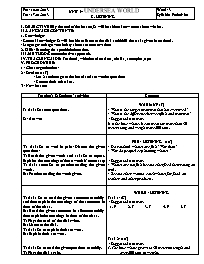Giáo án English 10 - Unit 9: Undersea world - C.Listening - Năm học 2012-2013

I. OBJECTIVES: By the end of the lesson, Ss will be able to know more about whales.
II. LANGUAGE CONTENTS:
1. Knowledge:
- General knowledge: Ss will be able to listen to the disk and fulfill the tasks given in textbook.
- Language: enlarge vocabulary about sea conservations
2. Skills: listening for specific information.
III. METHOD: Communicative approach.
IV. TEACHING AIDS: Textbook, whiteboard markers, chalks, some pics, tape
V. PROCEDURES:
1 / Class organization:
2 / Oral test: (5’)
- Let 2 students go to the board and answer the questions
- Correct their mistakes.
3 / New lesson:
Bạn đang xem tài liệu "Giáo án English 10 - Unit 9: Undersea world - C.Listening - Năm học 2012-2013", để tải tài liệu gốc về máy bạn click vào nút DOWNLOAD ở trên
Pre : 10.01.2013 Tea: 17.01.2013 UNIT 9: UNDERSEA WORLD C. LISTENING Week: 3 Syllable Period: 60 I. OBJECTIVES: By the end of the lesson, Ss will be able to know more about whales. II. LANGUAGE CONTENTS: 1. Knowledge: - General knowledge: Ss will be able to listen to the disk and fulfill the tasks given in textbook. - Language: enlarge vocabulary about sea conservations 2. Skills: listening for specific information. III. METHOD: Communicative approach. IV. TEACHING AIDS: Textbook, whiteboard markers, chalks, some pics, tape V. PROCEDURES: 1 / Class organization: 2 / Oral test: (5’) - Let 2 students go to the board and answer the questions - Correct their mistakes. 3 / New lesson: Teacher’s & Students’ activities Contents T: Asks Sts some questions. Ss: Answer WARM UP (5’) - What is the largest mammal that has ever lived? - What is the difference between fish and mammal? * Suggested Answer: It is the blue whale. It can measure more than 30 meters long and weigh more 200 tons. T: Asks Sts to work in pairs: Discuss the given questions: T: Reads the given words and asks Sts to repeat. Explains the meanings of these words if necessary. T: Asks some Sts to practice reading the given words. Ss: Practice reading the words given. PRE - LISTENING (10’) - Do you think whales are fish? Why (not)? - Why do people keep hunting whales? * Suggested Answer: - Whales are not fish because they feed their young on milk. - Because they want to catch whales for food, oil, leather and other products. T: Asks Sts to read the given sentences carefully and then explain the meanings of the sentences in front of the class. Ss: Read the given sentences in silence carefully then explain the meanings in front of the class. T: Plays the track of the disk twice. Ss: Listen to the disk. T: Asks Sts to explain their answers. Ss: Explain their answers. T: Asks Sts to read the given questions carefully. T: Plays the disk again. Ss: Listen and try to find the information to answer the given questions. T: Plays the disk once again if necessary. T: Asks Sts to compare their answers with each other. T: Asks Sts to answer the questions in front of the class. WHILE - LISTENING Task 1: (8’) * Suggested Answer: 1. F 2. T 3. T 4. F 5. T Task 2: (10’) * Suggested Answer: 1. The blue whale grows to 30 meters in length and over 200 tons in weight. 2. Because there is a lot of krill – their favorite food in cold water. 3. Cold waters in the North and South Atlantic Ocean and the North and South Pacific are their favorite feeding grounds. 4. Heavy hunting is the main reason for the decrease in whale population. 5. They have asked the International Whaling Commission to stop most whaling. 6. If we didn’t take any measures to protect whales, they would disappear forever. - Sts work in groups talking about THE BLUE WHALES information (length, weight,), - T reminds Ss their homework. - Ss listen and memorize. POST-LISTENING (5’) + Special features, + Areas where THE BLUE WHALES live, + Why do they feed in the cold Ocean?, + What are good feeding grounds? + What is main reason to decrease whale population?, + What happen – didn’t – take any measures to protect them? Homework (2’) - Learn by heart all new words. - Prepare for writing Comments & supplements:
Tài liệu đính kèm:
 C.listening.doc
C.listening.doc





